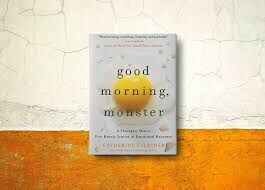Spirituality
Psychological Heroes
A conversation with psychotherapist Catherine Gildiner.
Posted October 6, 2020

I’m excited to share with you the new book of psychotherapy cases called Good Morning, Monster. Catherine Gildiner is a bestselling memoirist, a novelist, and a psychologist who practiced privately for 25 years. Her new book focuses on five brave men and women who overcame enormous trauma—and in her view, are heroes who should be celebrated. With a novelist’s storytelling gift, Gildiner recounts the details of her patients’ struggles and their paths to recovery all while weaving in her own tale of her growth as a psychologist.
Good Morning Monster has been compared to Lori Gottlieb’s Maybe You Should Talk to Someone. It’s described this way: “A therapist creates moving portraits of five of her most memorable patients, men and women she considers psychological heroes.”
Lynne: You describe your patients as having resilience. Can you talk a bit about what that means to you?
Catherine: Some define it as having the ability to bounce back. I saw each of my deprived patients as able to hold onto the tiniest scrap that was thrown their way, to expand it, and then utilize it. Take Peter, who was locked in an attic with only a crib for five years with only food delivered. Once, his mother gave him a tiny piano that someone had left in their restaurant. With it, he managed to make it into a loving parent. After pressing all the keys he would hold it to his chest and experience the vibration as his mother’s heartbeat. He expressed his feelings by playing sad or happy music. He interpreted the music as his mother giving him feedback and comfort. It is no wonder he grew up to be a well-known musician who was described in magazines as making his instrument “ring with emotion.”
Lynne: Why did you structure this book of cases with the first patient you ever had and finish with the last patient who brought you out of retirement?
Catherine: I wanted readers to follow my developmental arc. I was hoping that we could learn at the same time. I wanted readers to have the shock I had in leaving a sheltered academic program of many years of study where you learn theories and then hope to apply them.
I also wanted the reader to realize that the therapist can never let her guard down. My last patient, Madeline, fired me and only reluctantly came back to therapy. I had over-interpreted to her. Therapy is like an onion. You peel it layer by layer. Information should only come out when the patient is ready to transfer unconscious material to the conscious mind. I told Madeline what I thought her obsessions were covering before she was ready to hear it. I was less cautious than I had been at the beginning of my practice. It was a rookie mistake, but it can happen anytime. In some ways, you get wiser as you have more experience, but you have to be careful not to get cavalier.
Lynne: What did you learn from the patients you profiled? What can readers learn?
Catherine: Alana was my most disturbed patient who has lived through a nightmare for years. What I learned from her was how intricate the mind is and how no matter how convoluted her defenses got—through different personalities—she kept her sanity. Her defenses were arcane but brilliant. She reminded me of what Pierre Janet, one of the first psychiatrists said in the 19th Century: “Every life is a piece of art, put together with all means available.”
Another patient, Danny, was a native whose wife and young daughter had been killed in a highway accident. We had five years together where I learned a tremendous amount. He did not speak for the first several months of therapy. Not one word. Then for years afterward, he would spend at least 20 minutes per session in silence. Finally, at the end of the 5 years, when he was preparing to end therapy, I said, “Remember when you didn’t talk.” He said he had no idea what I was getting at. He thought conversation got in the way of knowing people. He wanted to spend time with me in silence to see if he could trust me.
I learned a lot about communication from Danny. I no longer feel the need to fill silences. I am much less concerned by what people say than how I feel with them.
Peter, the musician, who had been locked away for years, never disliked his mother. Instead, he always felt sorry for her and wanted to help her. The one request he had when I wrote his case for the book was to not make his mother look bad.
I was raised in the Catholic school system in the fifties and sixties. We were frequently reminded that we should forgive. I have to say it never fully sank in until I met Peter. His forgiveness was Christ-like and I am sure it was a big factor in his recovery. After all, anger and rage take a lot of energy that could be applied to healing.
Lynne: Speaking of Danny, the native patient, what did you learn about the limits of "white therapy?"
Catherine: Danny had gone to a residential school—a place that the Canadian government sent natives to so they could learn not to be natives. He was physically taken away when he was five and told never to say another word in his “savage” language. He was physically, sexually, and emotionally abused there. It was my job to get Danny to unleash some of his buried pain and that is what white therapy is good at. We did it and it worked.
However, I realized I was out of my depth so I reached out to an Indian psychiatrist, Dr. Brant, who counseled me on the cultural touchstones that for natives are different. You don’t teach children, you show by example. You don’t question others. It’s up to them to volunteer information. Competition is frowned upon. Dr. Brant told me it’s rude to give advice to anyone, even if you think they need it. It was then that I realized how intrusive Danny must have found therapy.
The most important thing Dr. Brant said is that an “Indian has to be an Indian.” Which cannot fully happen with a white therapist. The goal of white therapy is to make the individual aware of his unconscious motives so that he can be a high functioning individual in society and get his needs met. White therapy is all about making one person better. Native mental health is based not on individual well-being, but on the tribe’s functioning together.
There is no spiritual component in white psychotherapy. And Danny had to rediscover his spiritual side. He needed the native group and spiritual component to become whole. I was lucky that the native health community, such as it was 30 years ago, was so willing to step in and help me.
To learn more about Catherine Gildiner’s work and her writing, visit her website.




